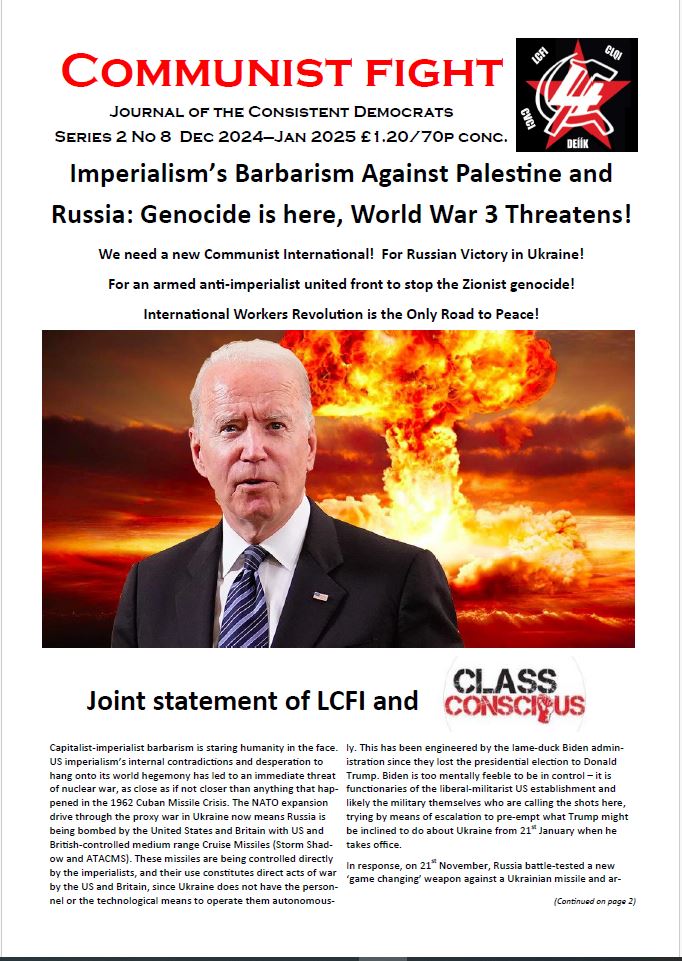This presentation with slides was given at a Consistent Democrats educational discussion on 28th September 2025. It is a preliminary discussion of the history of Christian Zionism. It cannot be said to represent a Marxist analysis in itself, but it could lay the basis to enrich our Marxist understanding of aspects of the history of Zionism.
A recording of the full presentation and discussion at this meeing is available here.
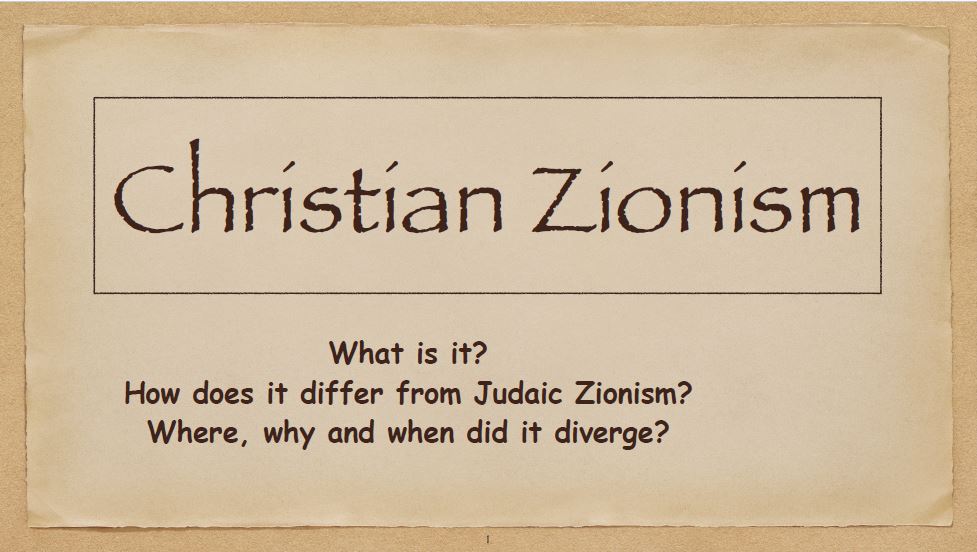
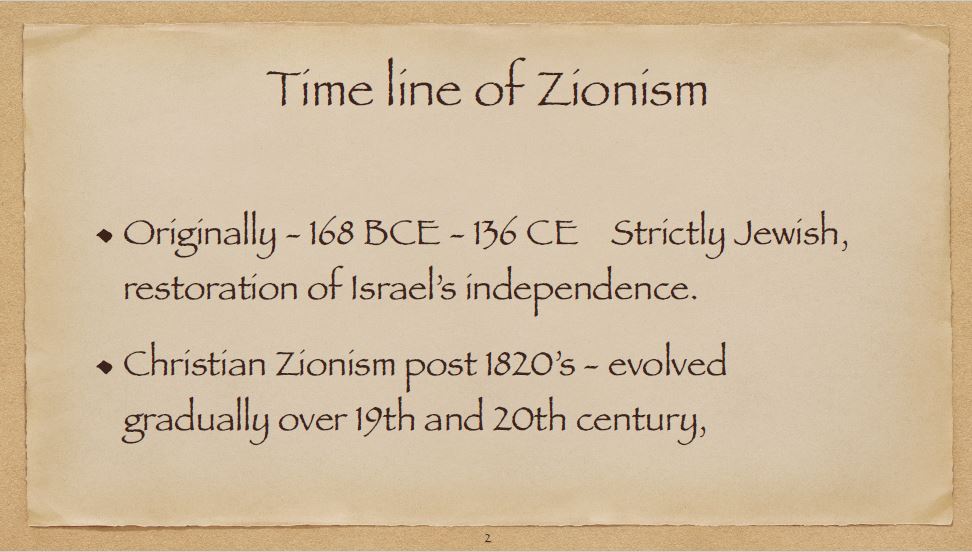
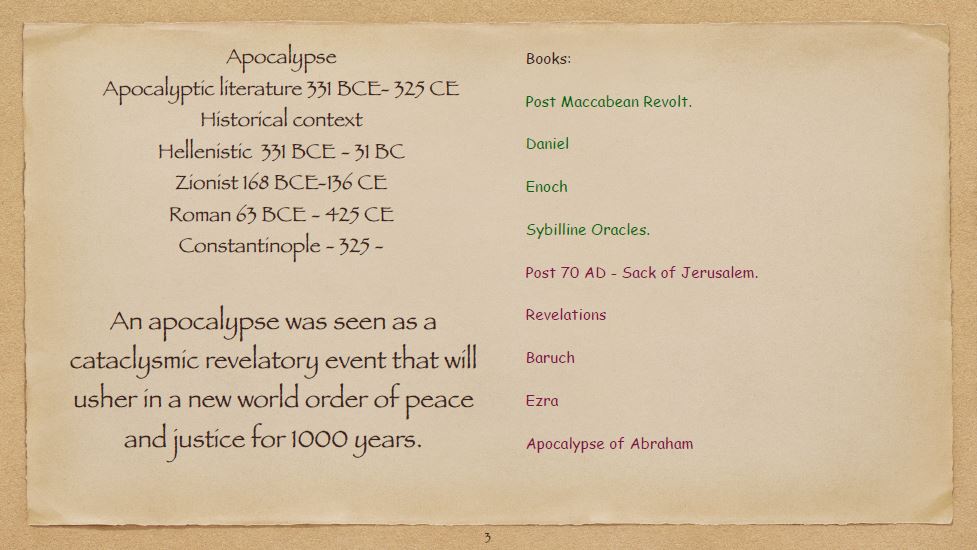
Judaic Zionism differs from Christian Zionism mainly because Satan will be defeated and locked up in hell for a 1000 years before being released again… even Satan gets probation, not execution. It focuses on the restoration of two ‘Messiahs’: priest and king, and the recovering of the 12 judges for the gathering of the 12 tribes together in the Kingdom of “God” i.e. Israel.
Apocalyptic literature for Christians mostly centres on the books of Revelation, Daniel, and Enoch. Written between 250 BCE and 250 CE, it now includes many books from the Hebrew Bible and Christian Bible. Apocrypha and the Dead Sea Scrolls indicate many more were influential up until the 400 CE. This clearly shows Jesus as an apocalyptic preacher rather than the divine Christian Messiah of the Nicene Creed and Constantine syndicalism.
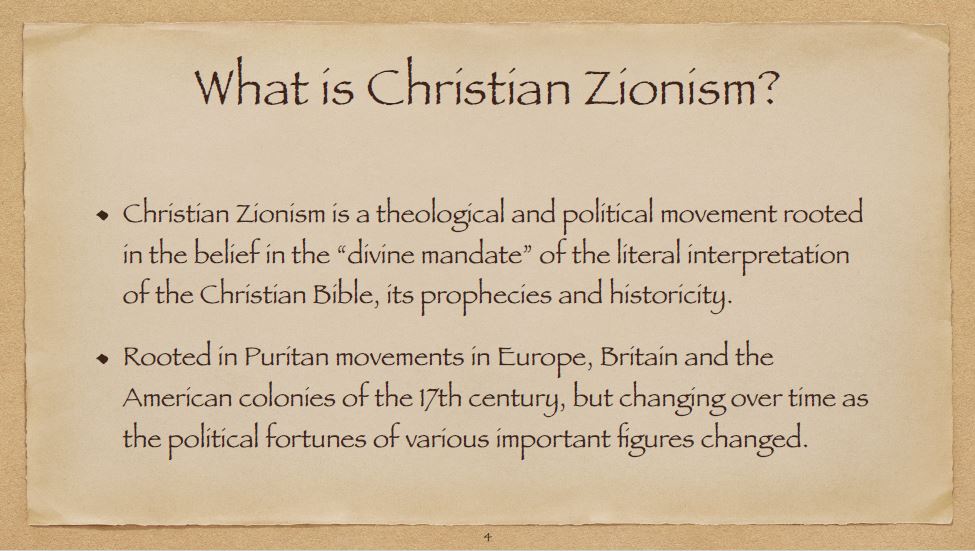
While most pundits trace Christian Zionism to the Puritans, I would say it is rooted in the Protestant Reformation which challenged the power of the Vatican by translating the Bible into the vernacular. In England, Scotland and Ireland, but in reality all over Europe, the Vatican insisted on the use of the Vulgate Bible, in Latin, which controlled the “Christian narrative”, (the majority written between 384 – 396 – mostly by St Jerome) and sought to enforce the Nicene Creed, and the authority of Rome by controlling “the message” of Empire, Church and State united. Notably this includes a number of deliberate “translational differences” – especially Genesis by omitting “who was with her” making Eve solely responsible for the sin of temptation rather than both Adam and Eve, and changing the order of the Gospels from Matthew, John, Luke, Mark.
After Martin Luther’s posting the 95 articles calling for Reformation, in 1517, This led to a determination to appeal to a “higher authority” by looking for better translations of the Bible into the vernacular, which with the printing press allowed “the Word” to be shared far more widely. Academics and church scholars collaborated with Greek and Hebrew as well as Latin scholars. A greater emphasis on the original Greek and Hebrew writings rather than Jerome’s translation, resulted in contesting and ultimately dismantling the hierarchy imposed by the Vatican by favouring different vocabulary (using for example “congregations” not the church, “elder” not priest, “repentance” not doing penance, and “love” not charity). In particular it emphasised salvation by faith alone, not the Mass and challenging the legitimacy of the “divine” power of both King and Pope, the separation of the faithful into priests and lay members in favour of returning Christianity to its earlier roots of individual congregations, all belonging to one church under God.

Over time, various Popes and Emperors, Kings and individuals clashed, leading to wars, witch hunts for heretics, non-conformists and eventually witches and pagans, schisms and a variety of moral dilemmas, from the Crusades, invasions, slavery, usury with indulgences being the final straw that broke the camel’s back. The original five churches, founded by the Patriarchs, Antioch (Peter), Rome (Peter), Constantinople (Andrew), Alexandria (Mark), Jerusalem (James) were the ranked; but Rome and Constantinople were rivals just like their Imperial counterparts.
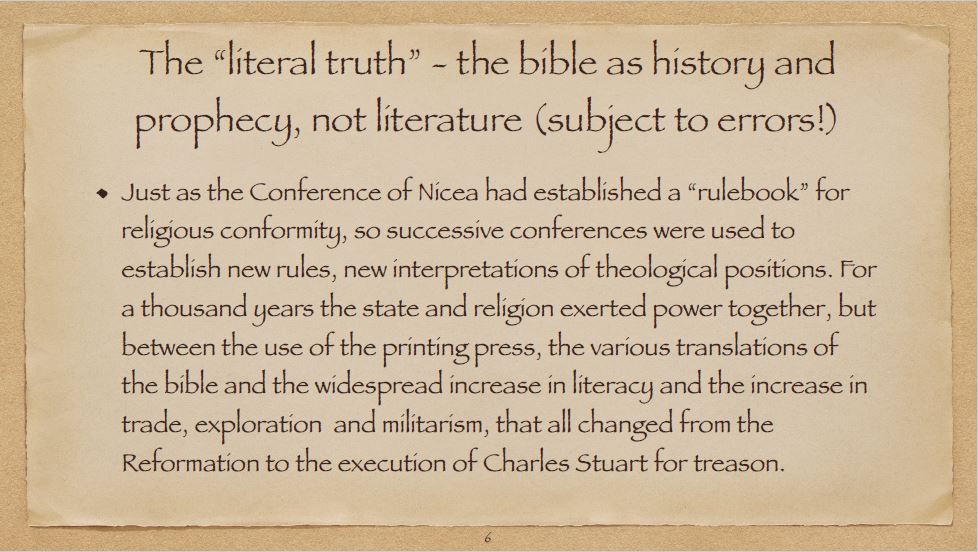
While some suggest that the earliest ideas of Christian Zionism start with Calvinism and Martin Luther’s 95 theses in 1517, and the first English bible i.e. Tyndale’s (1526) it is usually traced to the Puritans of the 17th century. Which had already split into two forms, Congregationalists (aka Separatists or Independents) and Presbyterians. They formed a coalition to fight the attempts of Charles to enforce his views on the Divine Right of Kings, autocracy, including the conversion of the country to Catholicism, resulting in the English Civil War, and the execution of Charles, and the adoption of the Westminster Confession, along with Oliver Cromwell as Lord Protector. He died in 1658, followed by his son Richard, before the latter resigned in 1659. Richard outlived all the Stuarts, dying in 1712. After the Restoration of the Monarchy, Puritans faced increasing persecution by the state, and the numbers going to the Americas, especially as “the Pilgrim Fathers” but others as indentured servants, i.e. transported, increased.
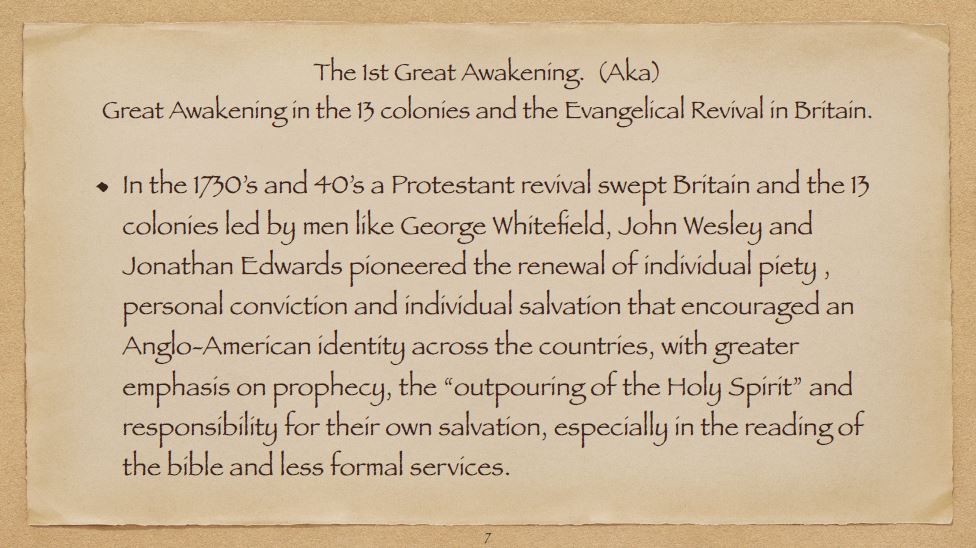
For some this has led to speculation that the Great Awakening resulted in the relatively bloodless US War of Independence fostering a sense of national identity in the colonies and greater expectations of democracy, personal responsibility and democracy. Others have argued that it was more about property, libertarianism and racism due to the continuing importation of slaves, and reliance on slavery in what was a collection of settler colonies, where the British, by 1776, were no longer willing to fund endless wars to fend off the French in Canada and the Spanish in Mexico without taxation. George Washington in particular owned more land than George III, while the use of non-white soldiers, from India and the Caribbean, upset the slave-owning colonials because they were both free and armed, something many feared. 20 and more years later, the French Revolution fulfilled both their fears, and determination to avoid a repetition in England.
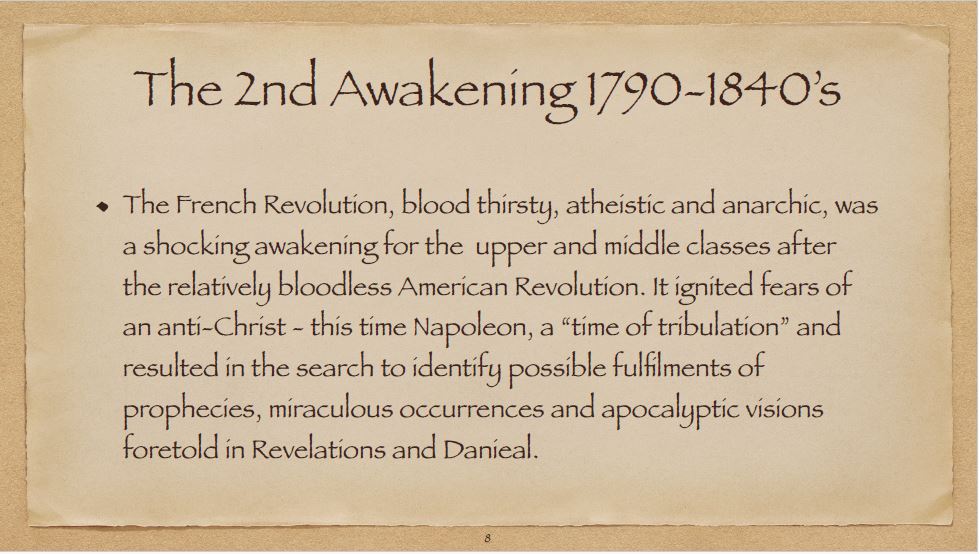
Whereas the first Great Awakening of the 1730’s and 40’s left the Anglicans, Lutherans, Quakers and non-Protestant by the wayside, the second Great Awakening was greeted by the Churches of England, Scotland and Ireland with much more enthusiasm, particularly amongst the clergy. By the 1820’s several influential clergy, MPs and influential gentry gathered to promote a new drive for greater religious engagement in all classes, with special emphasis on the Bible, prophetic inspiration and emphasis on “signs” and increased spirituality.
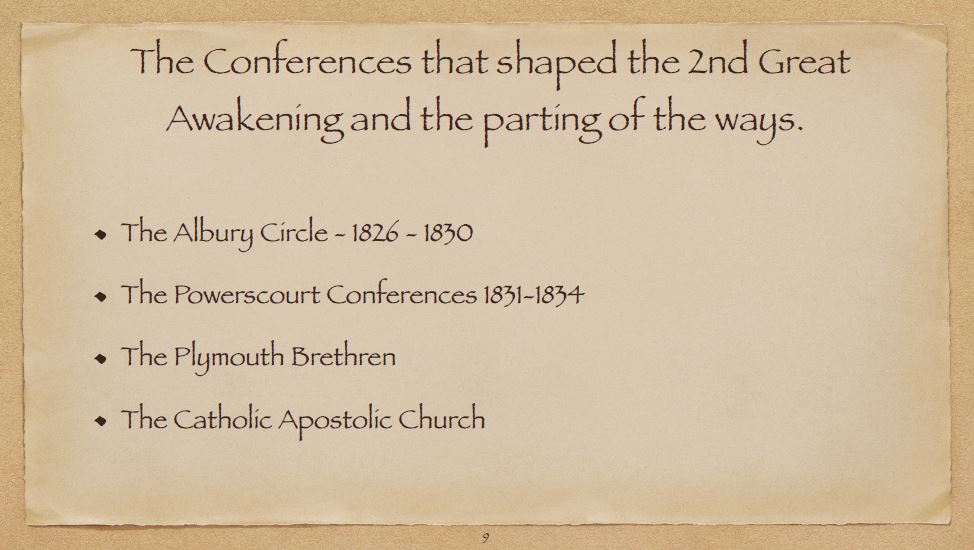
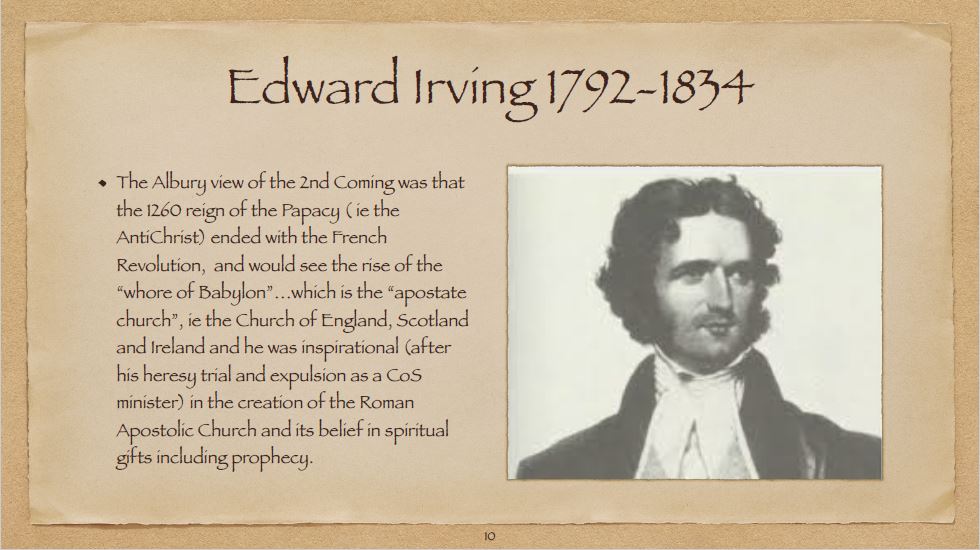
Edward Irving was an inspirational and popular preacher in Scotland and England, who gained his maths degree in 1809, his MA in 1810, and taught maths until he gained his divinity licence to preach in 1815 continuing to teach until he preached full-time by 1818. Although not as popular as he would later become, he later moved to London. In 1821, his popularity as a preacher was such that the Caledonian Church Hatton Garden invited him to become their preacher, and he was ordained in 1822. His sermons and books attracted many thousands and while many saw him as the inspiration for the Catholic Apostolic Church, his popularity waned by 1827 with the crowds but impressed the Albury Circle with his mysticism and interests in prophecy and spiritualism. His career was cut short, in 1834, when he died of TB during a tour of sermons in Scotland.
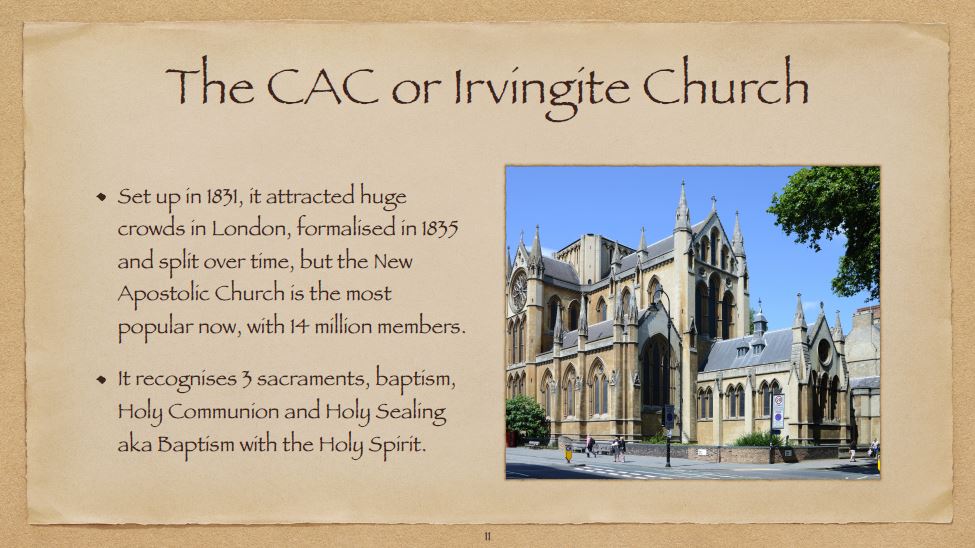
The church was organised in 1835 with the fourfold ministry of “apostles, prophets, evangelists, and pastors” The denominations in the tradition of the Catholic Apostolic Church teach “the restoration to the universal church of prophetic gifts by the direct inspiration of the Holy Ghost.” Irving’s support for those with “prophetic gifts”, his expulsion from the Church of Scotland for ‘heresy’, and his belief in a coming “new dispensation”, are thought now to be his main contributions. This church in Bloomsbury was built then and is owned by the trust. Original “apostles” included John Bates Cade, Henry Drummond, Spencer Perceval, Thomas Carlyle, Duncan Mackenzie. The denominations in the tradition of the Catholic Apostolic Church teach “the restoration to the universal church of prophetic gifts by the direct inspiration of the Holy Ghost”.
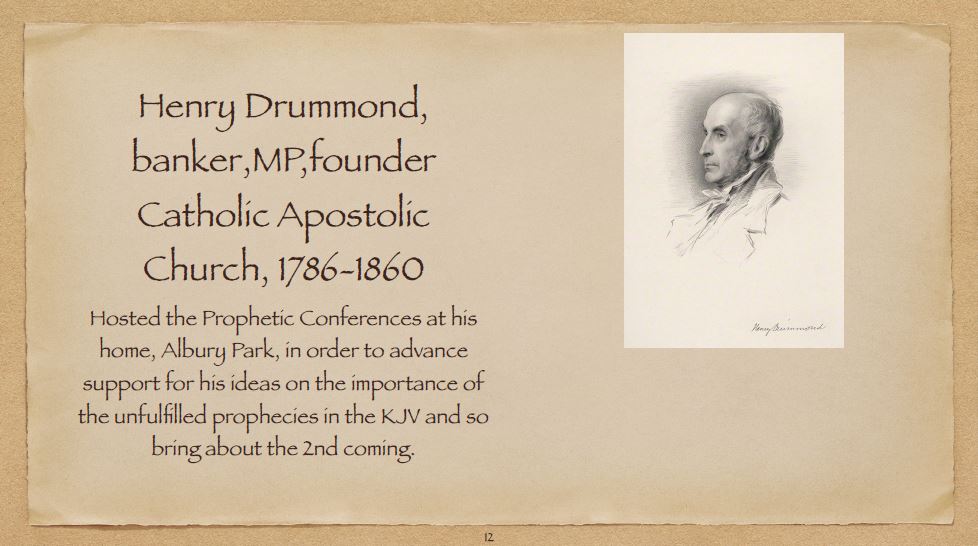
After the untimely death of Edward Irving in 1834 of TB during a tour of Scotland, Drummond set up the Catholic Apostolic Church
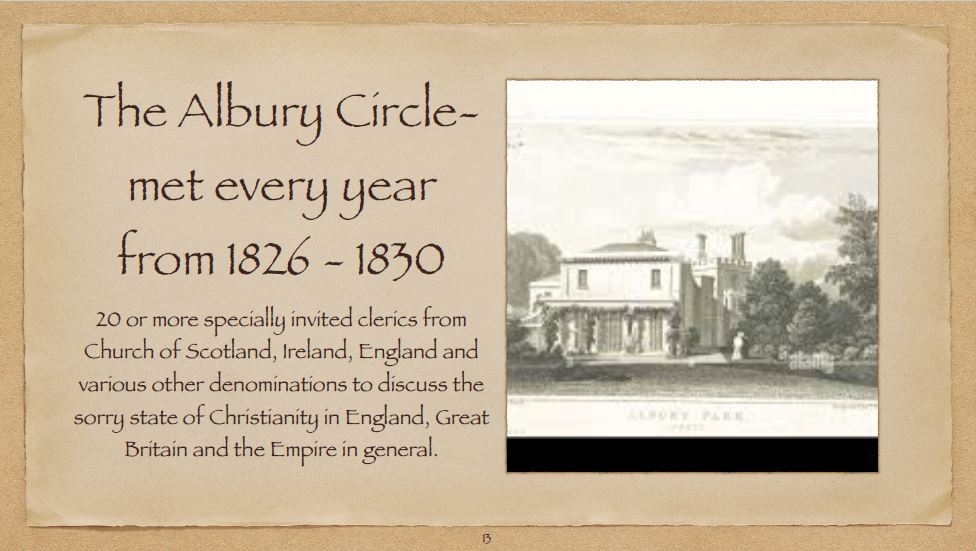
Elements from the Church of England, Congregationalists, Presbyterians, attended a week-long conference on Prophecy, unfulfilled, in the Bible and the expected Second Coming given the increasing concerns over the trials and tribulations, and 1260 years (Daniel 7:25 and Revelation 13:5 both speak of a period of 1260 days, which is interpreted by some as a symbolic representation of 1260 years) from Justinian 1 to 1798 , i.e. the French Revolution, with Napoleon initially cast as the Anti-Christ, and what should be expected next. This Influenced the development of increased interest in prophecy, 7th day Adventists, and other splits.
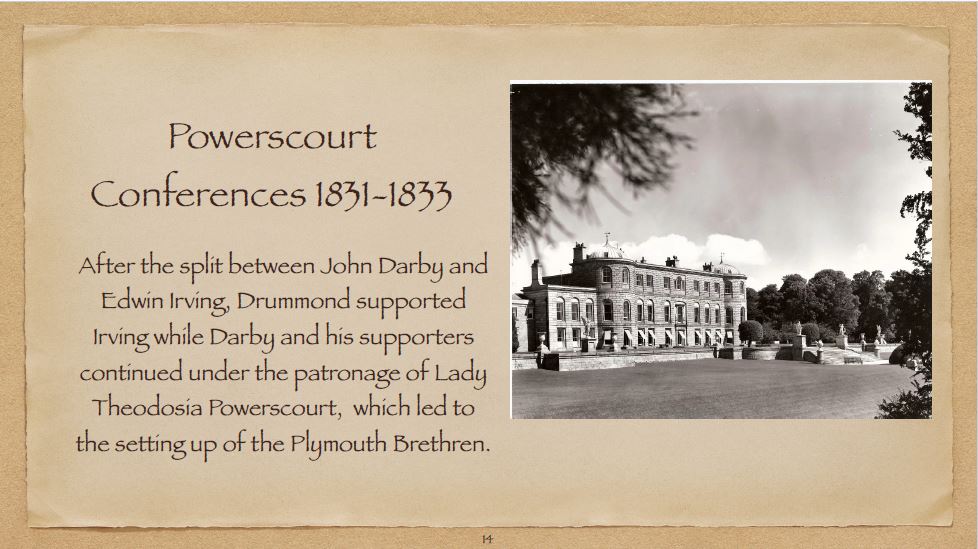
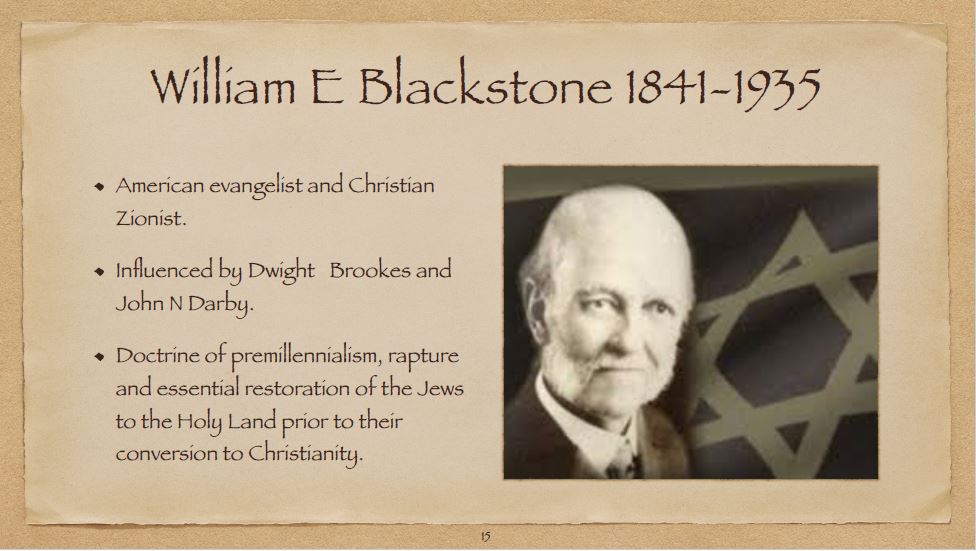
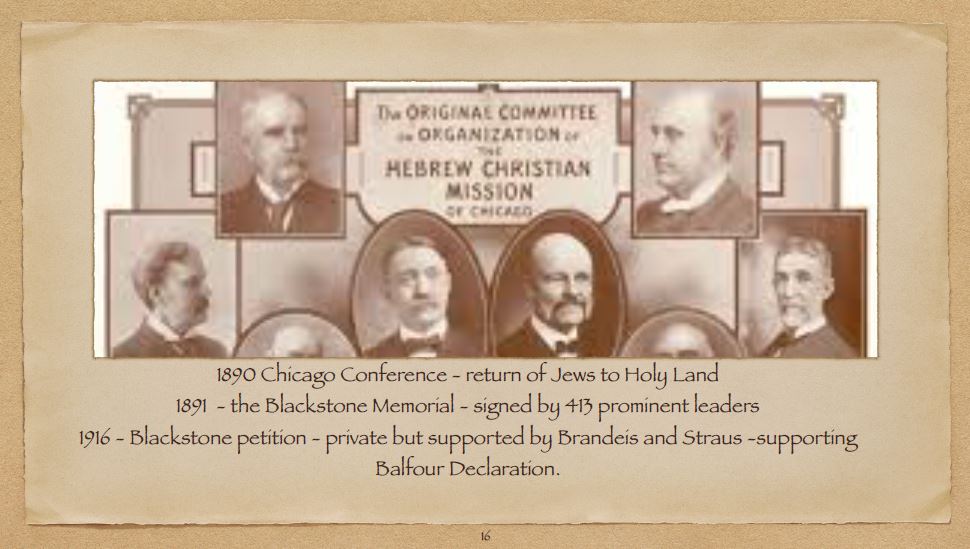
The Blackstone Memorial of 1891 also influenced the choice of Herzl to reject the British offer of East Africa (Uganda) as a new Jewish homeland to avoid pogroms and instead continue to demand Palestine from the Ottoman Empire. He presented a bible to Herzl with the prophecies of return underlined in Red, and Evangelical support and influential connections for American Zionism included Rockefeller, J P Morgan, and Chase. As well as support from both Methodist and Presbyterian Churches (Woodrow Wilson was an ardent Presbyterian). There was a petition of prominent political and religious leaders to President Harrison for the creation of a Jewish Homeland of Israel in Palestine.
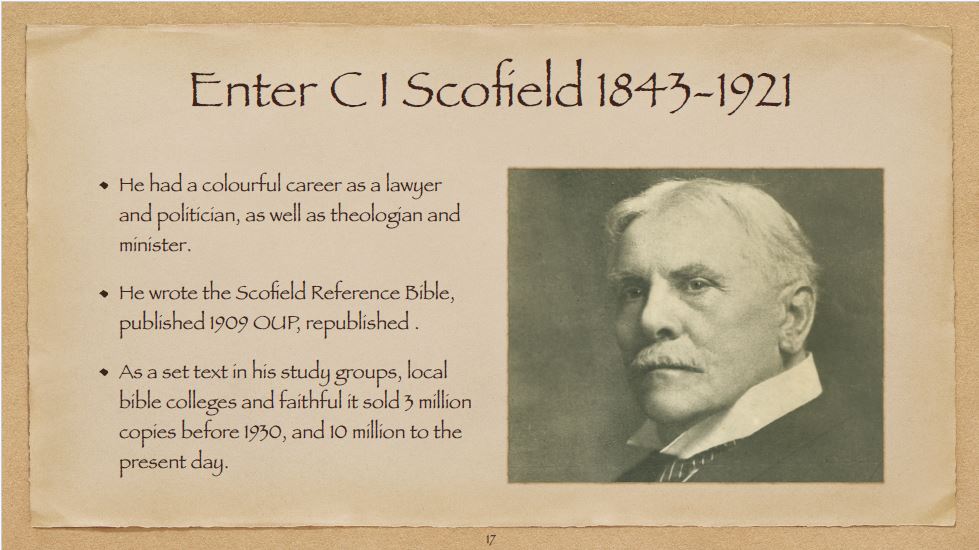
Schofield was born in Michigan into an Episcopalian family (although his roots were Puritan). He served on the Union side in the American Civil War, married and had two daughters, using the connections of his wife’s Catholic family to become a lawyer and pursue a political career, as a Kansas Senator and Deputy Attorney General in Kansas (at 29, the youngest in the country). He was forced to resign for fraud: embezzling political funds, taking bribes and forging cheques. He abandoned his wife and daughters, who divorced him in 1883 for desertion, and decamped to St Louis, Missouri to work with Dwight L Moody, an influential Evangelist, marrying his second wife upon his divorce.
Untermeyer funded/provided the contacts to get his Reference Bible published in England. This pushed a specific form of Zionism, specifically support for a Jewish state in Israel, the duty of Christians to support the Jews as the Chosen by God, as well as dispensationalism and premillennialism. This became the forerunner of the current fundamentalist Christian Zionism. The format of the book printed the whole of the King James Version with notes on every page, and chains of references showing where specific Old and New Testament prophecies were linked, as well as opinions, fostering his views as “Gospel” and literally the Word of God. Consequently it was presented in a format where “believers” were encouraged to see the Bible as the literal word of God, along with these very specific, and often quite disingenuously distorted commentaries, as equally authoritative.
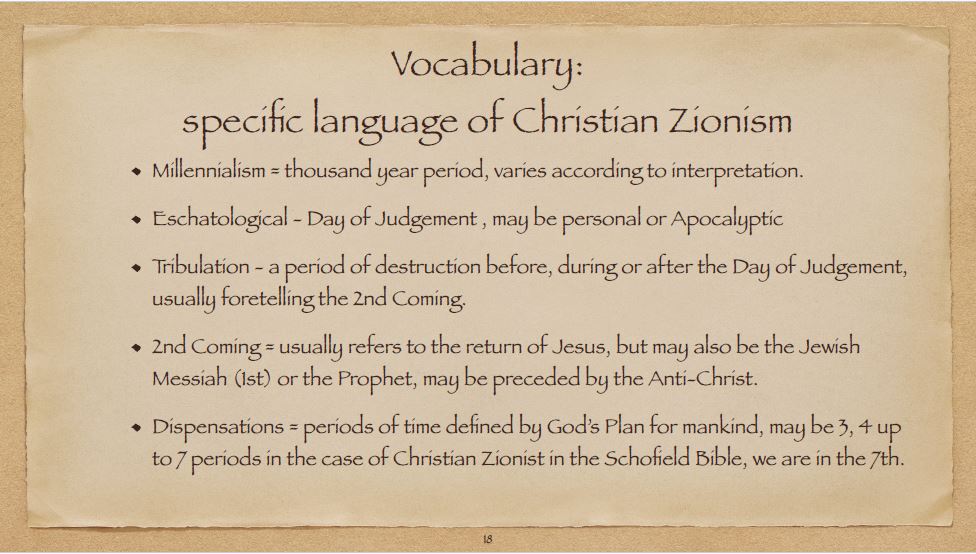
Millenialism and premillennialism – these are about how and where Christ’s Second Coming is said to precede his 1000-year reign. For millennialism, Christ’s reign is currently taking place in the form of the Church – so there is no Second Coming. With Post-millennialism – the Second Coming will only happen after the millennium, but maybe after the Jewish Messiah and the 3rd Temple. The rapture is said to be a state of grace in which the chosen are swept up by the Christ of the Second Coming and protected from the tribulation, and the millennium, to share eternity with those Jews who have been “saved” by Christ/Messiah. This was popularised by Irving and Darby, who were inspired by Margaret MacDonald, who experienced a series of prophetic visions in 1830.
Thanks to the literal interpretations of the Bible by the various Protestant churches, the Apocalypse was seen as a cataclysmic event rather than a political change, or personal experience of intense ecstatic inner transformative vision.
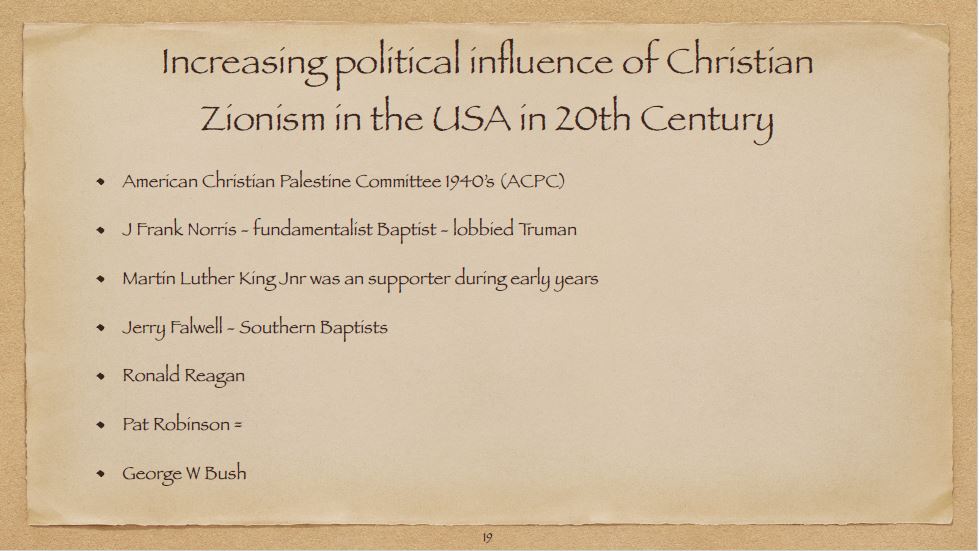
The Protestant Evangelist William E. Blackstone was an early advocate for the resettlement of Jews in Palestine. In 1891, he presented the “Blackstone Memorial”—a petition signed by hundreds of prominent Americans, including congressmen and business leaders—to President Benjamin Harrison. It urged for the creation of a Jewish homeland in Palestine and influenced early Christian Zionist thought. The American Christian Palestine Committee (ACPC) was formed in the 1940s. The ACPC was a powerful lobbying group composed largely of liberal and mainline Protestants. Its members, who included congressmen and religious figures, advocated a Jewish state in Palestine, viewing it as a safe haven for Jews fleeing persecution in Europe. After Israel’s founding, the ACPC continued its work, lobbying against the internationalisation of Jerusalem.
A fundamentalist Baptist, J. Frank Norris, was an early promoter of political action in support of Zionism. He used his influence in the 1940s to preach that it was a Christian duty to support the Zionist cause, writing to President Truman on the matter. Martin Luther King Jr., although more widely known for the Civil Rights Movement, is also cited as a Christian supporter of Israel and Zionism during this period. Jerry Falwell, a highly influential Southern Baptist televangelist and moral conservative, helped make support for Israel a central part of the Republican Party platform in the 1970s and 80s. He co-founded the Moral Majority, which became a powerful lobby within the party. The 40th US president, Ronald Reagan, openly courted the new religious right and was influenced by Falwell and others who saw support for Israel as biblically mandated. Another prominent televangelist, Pat Robertson followed Falwell as a key figure of the religious right in the 1990s, using his Christian Broadcasting Network to advance Christian Zionist perspectives. As president, George W Bush openly courted the fundamentalist Christian groups who were a core part of his base and who strongly supported his policies concerning Israel.
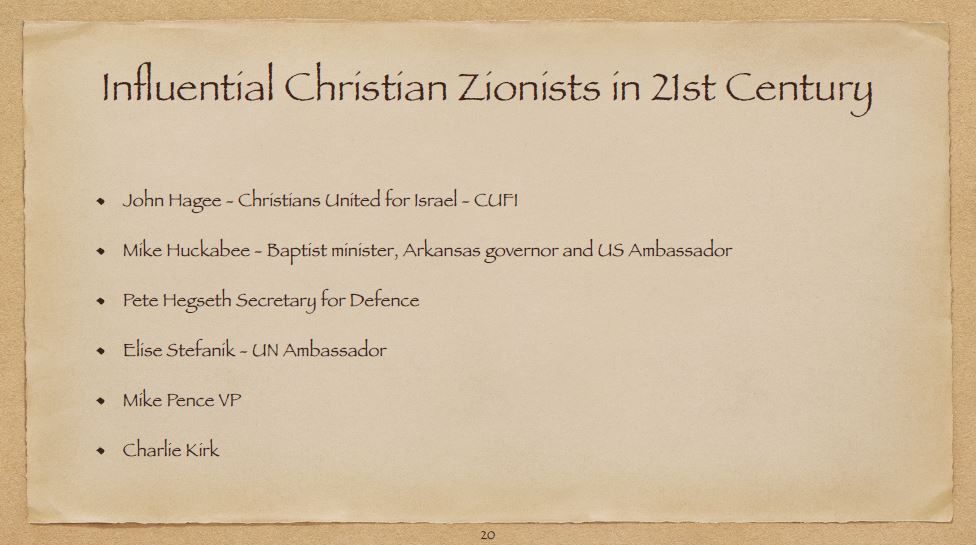
The founder and chairman of Christians United for Israel (CUFI), which has over 10 million members, John Hagee is one of the most prominent leaders of the modern Christian Zionist movement. His organization significantly influences Republican politics and US policy toward Israel.
The 45th/47th US Donald Trump has fostered close ties with Christian Zionist leaders like John Hagee and has appointed Christian Zionists to high-level positions. Actions taken during his presidency that pleased the Christian Zionist base included moving the US embassy to Jerusalem.
A Baptist minister and former Arkansas governor, Mike Huckabee is a leading Christian Zionist. Appointed as ambassador to Israel by Trump, he has made controversial statements reflecting Christian Zionist views, including referring to the occupied West Bank by the biblical names Judea and Samaria. Pete Hegseth, Trump’s pick for Secretary of Defence, iis a Christian Zionist who has claimed that the Bible gives Israel the right to the West Bank. Elise Stefanik, who was appointed as UN ambassador by Trump, has stated that Israel has a “biblical right” over the West Bank. Mike Pence, Vice President under Donald Trump in his first term, consistently embraced Christian Zionist themes, often linking American support for Israel to biblical prophecy.
The Christian Zionists have been particularly prominent in the Republican right since the 1970’s as opposed to the Jewish Zionists who were more prominent in the Democrats… reflecting in Starmer/European leaders panicking over the re-election of Trump, as opposed to Biden’s successor as Democratic nominee, Harris, in 2024.
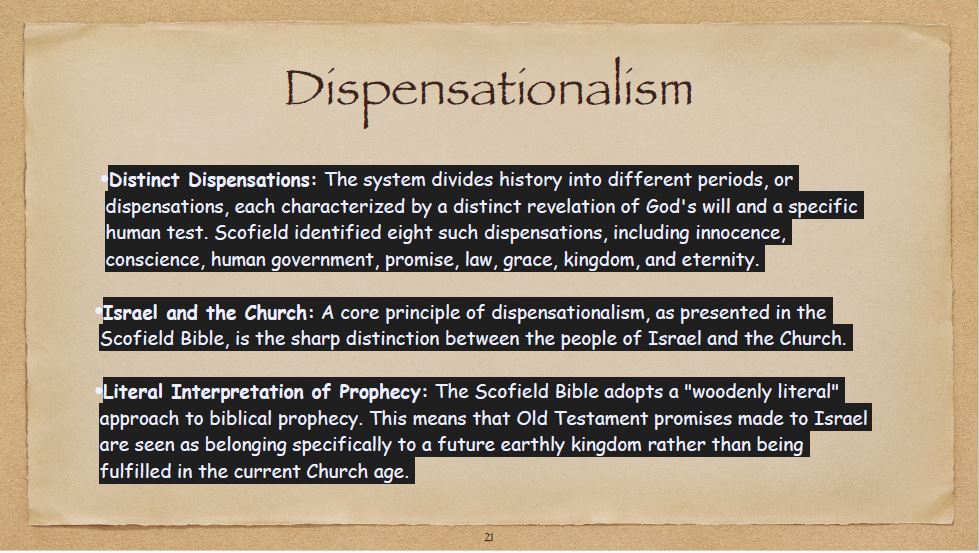
The Scofield Reference Bible’s support for Zionism is found in its interpretive notes, not in the biblical text itself. The notes popularize the theological framework of Dispensationalism, which holds that God has a separate plan for the Jewish people from the one for the Christian Church. A key interpretive element is the belief that biblical prophecies concerning Israel’s restoration must be literally fulfilled. The Scofield notes connect support for modern-day Israel to specific biblical verses through this theological lens.
The Scofield Reference Bible promotes Zionism through its annotated commentary on key biblical passages, not by altering the biblical text itself. These notes, based on the theological framework of Dispensationalism, interpret prophecies literally, leading to the belief that the modern state of Israel is the fulfilment of God’s biblical promises to the Jewish people.
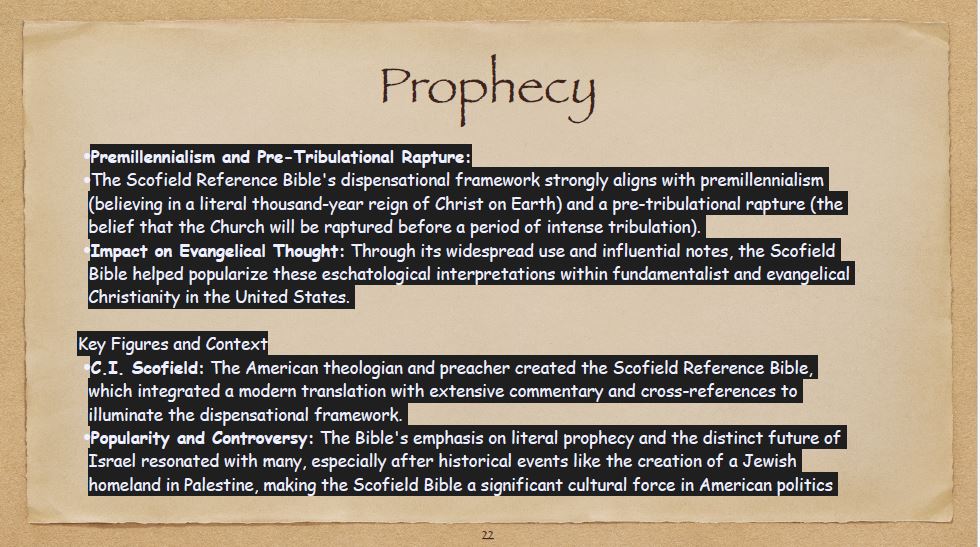

The Roman Catholic Church has formally rejected the “replacement theology” or “supersessionism,” which posits that Christians have entirely replaced Jews as God’s chosen people. After the Second Vatican Council (1962–1965), the Church affirmed that God’s covenant with the Jewish people remains valid and has never been revoked. However, elements of what is called “fulfilment theology” or “soft supersessionism” continue to shape the Catholic understanding of salvation history. This complex teaching asserts that the New Covenant established by Jesus Christ fulfils and perfects the Old Covenant, which leaves the ongoing theological status of Judaism open to interpretation and debate.
Vatican 1 (1869-70) – Papal primacy: The Roman Pontiff holds “full and supreme power of jurisdiction” over the universal Catholic Church. The Pope’s authority is understood to be ordinary and immediate, extending to all churches and all the faithful, not just in matters of faith and morals but also in matters of discipline and governance. Papal infallibility means the Pope is preserved from error when he defines a doctrine concerning faith or morals ex cathedra —that is, when speaking from the chair of Peter in his official capacity as pastor and teacher of all Christians.
The definitive change in Catholic teaching on this subject came with the Second Vatican Council of 1965-7, particularly in the 1965 declaration Nostra Aetate. The document explicitly states that “the Jews should not be presented as rejected or accursed by God”. It quotes Romans 11:29, which says, “the gifts and the calling of God are irrevocable”. This was a historic turning point away from centuries of theological interpretations that promoted the idea that God had punished and abandoned the Jewish people for not accepting Christ.

Scofield’s interpretation, Dispensationalism, emphasizes a literal reading of Old Testament prophecies concerning Israel’s restoration to its land and prominence. This includes passages in books like Ezekiel (e.g., chapters 36–37) and Isaiah (e.g., chapter 11), which promise the re-gathering of Israel from the nations. These prophecies have an obvious Zionist application and are seen as being fulfilled through the Zionist movement and the establishment of the State of Israel. For many who follow this interpretation, the modern nation is proof of God’s continuing faithfulness to the Jewish people and the unfolding of his End-Times plan.

Christian Zionists post 1840’s saw increasing attempts to “convert” Jews to Christianity as a divine purpose, funding missions, increased interest in Biblical archaeology, and clashes when resistance to conversion led to pogroms and further diaspora in an attempt evade persecution. Efforts to bring about the Second Coming, with the various European empires arguing over the best way, didn’t blame themselves but rather the Ottoman Empire, alternately supporting it against Russia in the 1850/60’s and dismembering it in WWI. Between the Balfour Declaration and the Sykes-Picot Agreement, Britain, France, Russia (until the Revolution) and Italy, along with the US, agreed to the division of the Middle East, and the eventual establishment of a State of Israel.

Christian Zionists differ from Jewish Zionists post-1895 in that they expect the post-apocalyptic Messiah to convert all Jews to Christianity and usher in a post-millennial 1000 year reign of peace and prosperity for all Christians, whereas others see it more as an era of World Domination for Israel and all true believers.
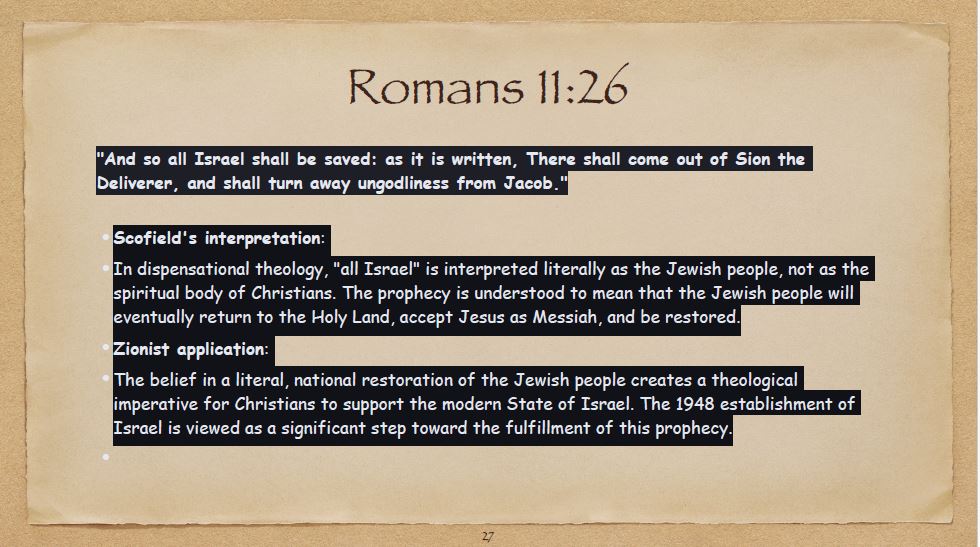
Over the last 75 years this has led to the increasing view amongst Christian Zionists that the State of Israel must be defended at all costs, unconditionally, and more importantly, uncritically of the fate of the rest of the human race. Including against other Christians, Muslims and all other religious beliefs or none, in order to bring about the Third Temple, the Messiah and the Rapture. All means including ethnic cleansing, genocide and the use of first strike nuclear weapons are permitted where they deem it necessary to bring about the Apocalypse.

